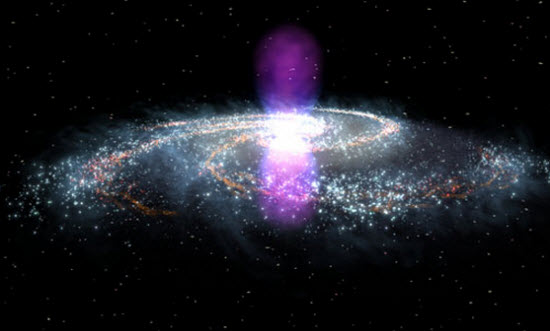If you've ever looked up at the night sky from a really dark place, you might've seen the narrow band of the Milky Way.
如果从一个晦暗的地方遥望夜空,可能会看到银河以一条细带的形式出现。
Our galaxy is a hundred thousand light-years across, but it looks so thin to you because you're seeing its disk edge-on,
银河系维度大约有10万光年,但在我们看来却很细,因为我们看到的是侧面,
and there's not much above or below it to light up the sky.
它上面和下面发出的光都没能映照在夜空中。
Still, if you happened to have superhuman vision, you might see a totally different picture:
不过,如果我们有超人一般的视力的话,那么我们看到的夜空中的银河系将会完全不同:
two enormous plumes of light, bulging out of the Milky Way's center. Scientists call these Fermi bubbles.
我们会看到两片光线形成的巨大羽毛,从银河系中心支出来,科学家称之为费米泡。
They were discovered less than a decade ago, and they could have a lot to teach us about the center of our galaxy.
费米泡是不到10年前发现的,从它们身上,我们能了解到很多有关星系中心的知识。
That is, if we can figure out where they came from.
这些知识就是从研究费米泡从何而来而得知的。
No matter how hard you try, you can't see Fermi bubbles normally because they shine not with visible light, but with gamma rays.
无论肉眼多么使劲儿,也看不到费米泡,因为费米泡发出的并非可见光,而是伽马射线。
These rays are the most energetic form of light, and they're really, really tiny:
伽马射线是能量最强的一种光,而且它们非常非常的小:
Powerful ones can have a wavelength a million times smaller than what your eyes can detect.
强伽马射线的波长是可见光的1/100万。
So unless you happen to have a gamma-ray telescope, there's no hope for you skywatchers. Fortunately, though, NASA has just the right equipment.
所以,如果没有伽马射线望远镜,用肉眼是看不到伽马射线的,不过,幸运的是,美国宇航局有这样的设备。
Gamma rays are really common throughout the universe, and NASA studies them using the Fermi Gamma-ray Space Telescope,
伽马射线是宇宙里一种普通的现象,美国宇航局就通过费米伽玛射线空间望远镜来研究伽马射线,
which has been orbiting the Earth since 2008.
这台望远镜自2008年以来就一直环绕着地球飞行。
Still, even once the telescope was launched, it took another two years for scientists to notice the Fermi bubbles.
不过,就算动用了这台望远镜,科学家还是花了2年时间才观测到费米泡。
That's because, in space, gamma rays are so common that they create a sort of fog.
这是因为,在宇宙里,伽马射线非常常见,所以就产生了一种遮掩的感觉。
It comes from sources like supernovas and black holes all over the universe, and it's so permeating that it concealed the bubbles for a while.
这种遮掩的感觉来自宇宙里各处都存在的超新星和黑洞,它们掩盖了费米泡的存在。
They were only found in 2010, when researchers working on another investigation just happened to be filtering out noise from the fog.
2010年,我们才发现了费米泡,当时天文学家恰好在做另一项研究,而这项研究恰好过滤掉了掩人耳目的东西。
But now that we know where to look, they're kinda hard to miss.
现在,由于我们已经知道在哪里可以找到费米泡了,所以就太容易错过了。
Each stretches more than 25,000 light-years across space, blossoming out of the galaxy's very center.
费米泡维度都有2.5万光年,从星系中心伸展开来。

For comparison, the Milky Way's disk is only about 1,000 light-years tall. So these things are enormous.
这里为了展现对比效果,温馨提示一下银河系的高度也不过只有1000光年左右,所以,费米泡体积是非常惊人的。
Even though they're often described as gamma ray bubbles, it's worth noting that the bubbles aren't actually made of light.
虽然费米泡总是被称为伽马射线泡,但值得注意的是费米泡并非由光形成。
After all, light normally travels in straight lines. Instead, they're made of super hot plasma, which emits the gamma rays.
毕竟,光通常情况下是要沿直线传播的,相反,费米泡是由温度极高的等离子体组成,从而可以放射出伽马射线。
Right now, there are two basic hypotheses about where all that plasma comes from.
现在,对于这种等离子体从何而来有两种基本的假设。
One option, called the black hole hypothesis, suggests that it came from the black hole at the middle of our galaxy.
第一种假设名为黑洞假设,也就是认为费米泡是从星系中心的黑洞中来。
After all, the Fermi bubbles seem to come from the galaxy's center, right where our enormous supermassive black hole lurks.
这种假设是基于费米泡看起来就像是从星系中心伸展出去的一样,而星系中心也是超重黑洞发生作用的地方。
In other galaxies, it's pretty common to find huge jets of gas blasting out of the top and bottom of a central black hole.
其他星系里经常可以发现气体从中心黑洞的顶部和底部喷射出去。
So it makes sense that our galaxy wouldn't be much different.
所以,银河系应该也大同小异。
As gas, dust, stars, and, well, anything falls toward a black hole, friction and pressure heat it up until it vaporizes into a plasma.
气体、灰尘、恒星等物体掉落在黑洞的过程中会产生摩擦和压力,从而提高了黑洞的温度,使黑洞蒸发为等离子体。
But sometimes, that plasma doesn't actually fall into the black hole.
但有时候,等离子体是不会掉落在黑洞中的。
Sometimes it just whips around and shoots out the top or bottom, instead.
有时候,等离子体在四处漂浮后,会顶部或底部喷射出去。
And maybe that's where the Fermi bubbles come from. Now, these days, our supermassive black hole is pretty quiet.
这样,就形成了费米泡,如今,超重黑洞都是十分静谧的。
But according to data from the Hubble Space Telescope, it might've pulled in enough material around six to nine million years ago to form these glowing blobs.
不过,根据哈勃太空望远镜观测到的数据,黑洞可能充分吸引了600万-900万年前的物质,形成了漂浮的斑点。
So maybe we're just seeing the leftovers of the black hole having a huge snack.
所以,或许我们看到的是黑洞的残留物吞食其他物体而已。
Now, according to another idea, Fermi bubbles might not have come from a black hole at all.
下面说说另一种假设,这种假设认为,费米泡根本不是来自于黑洞的。
Instead, the star formation hypothesis points out that there's something else lurking at the center of the Milky Way:
相反,这种恒星形成假说认为是银河系中心有东西流泻而出:
what astronomers call a star-forming region.
科学家称之为产星区。
These regions are capable of rapidly churning out new stars and, along with them, big outflows of particles like electrons.
产星区可以快速产生新的恒星并随之流出大量微粒,比如电子。
So many, the electrons are causing the Fermi bubbles, instead. So far, there's some evidence for this hypothesis, too.
流出的大量电子形成了费米泡,目前也有一些证据可以证实这种假说。
But to find it, you've got to look all the way on the other end of the electromagnetic spectrum at radio waves.
但是要找到费米泡,得在电磁谱的另一端观察无线电波才可以。
By studying the Fermi bubbles in these wavelengths, astronomers discovered they were emitting a special kind of radio emission, called synchrotron radiation.
通过波长来研究费米泡,天文学家发现,费米泡释放出了一种特殊的无线电波,名为同步加速器辐射。
It's produced when electrons move in the presence of a powerful magnetic field, and strong fields like this are a common signature of star-forming regions.
这种同步加速器辐射产生的条件是:电子在强力磁场中移动。这种强力磁场是产星区的标配。
Of course, these fields are also found around supermassive black holes, too, so that's not the only evidence.
当然了,超重黑洞附近也有强力磁场,所以不能根据这个证据下决断。
The radio wave data also revealed ridges or ripples in the Fermi bubbles, which could also be signals of a star-forming region.
无线电波的数据还揭示出费米泡中存在脊线或波纹,这可能也表明这里是产星区。
The region could imprint that spiral, ripple-like pattern in the bubbles as it circles our galaxy's black hole.
产星区可以在环绕银河系黑洞的过程中,在费米泡里标记出螺旋状的波纹图案。
As a bonus, if rapid star forming has been using up all the gas and dust at our galaxy's center, that could also explain why our black hole has been so quiet!
如果快速形成恒星的过程用光了银河系中心的所有气体和灰尘,那么我们就可以解释黑洞为何如此静谧了!
If this is the right answer, those ripples could help us track the history of star formation over the last ten million years.
如果这是正解,那么这些波纹就可以帮助我们找到过去1000万年来恒星形成的历史了。
We'll definitely need some more detective work to figure it out.
我们还需要用侦探的眼光来研究这一切,才能找到问题的答案。
But whatever their cause, black hole or star formation, Fermi bubbles are a good reminder that there's a lot more to the universe than meets the eye!
但无论形成原因是什么,无论哪种假说是正确的,费米泡的存在都很好地提醒了我们:肉眼看不到的宇宙奥秘还有很多!
Thanks for watching this episode of SciShow Space!
感谢收看本期的《太空科学秀》!
If you'd like to learn more about the supermassive black hole at the center of the Milky Way, you can watch our episode all about it.
如果大家想了解更多银河系中心超重黑洞的奥秘,有相关的专题视频哦!


